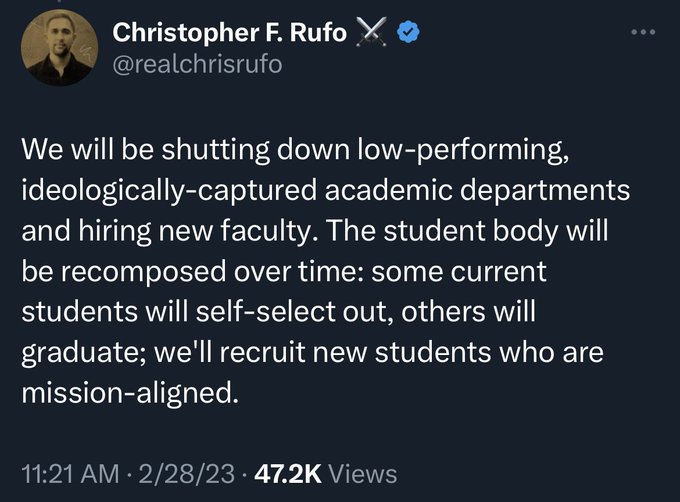Kepler
Si certus es dubita
Don't give the Republicans any ideas.
CTP assesses with moderate confidence that the Iranian regime is tolerating a country-wide, coordinated campaign to poison Iranian school girls. Social media users documented incidents of chemical poisoning at 26 girls’ schools throughout the country on March 1 alone.[1] Hundreds of Iranian schoolgirls have reported respiratory and neurological poisoning symptoms since November 2022, many of whom have required hospitalization.[2]The first reported incident occurredon November 30, 2022, in Qom City, Qom Province when 18 Shahed Razaviyeh Secondary School students reported experiencing nausea, coughing, difficulty breathing, heart palpitations, and lethargy.[3] Initial poisoning cases primarily affected female high school students in Qom. In recent weeks, however, poisoning cases have spread across Iran and have also targeted elementary, middle school, and university students, as well as less frequent incidents at boys’ educational facilities.[4] CTP recorded a significant increase in poisoning cases on March 1, with students from at least 26 schools falling ill. Most poisonings on March 1 occurred in Tehran and Ardabil Provinces.[5] It remains unclear why these cities appear to have been disproportionately targeted.
There is presently no evidence to indicate which individuals are responsible for this months-long campaign against Iranian school girls, and Iranian officials have acknowledged and are investigating such incidents.[6] CTP nevertheless assesses with moderate confidence that a network of individuals whom the regime tolerates has coordinated this campaign and that the regime has allowed them—at least for now—to do so. CTP bases its assessment on indirect evidence that shows the regime has not sufficiently responded to the poisonings despite their severity of the harm to Iranian girls. Iran also maintains a security apparatus capable of handling such matters, as it has demonstrated in responding to larger-scale developments. Iranian officials have not articulated a coherent narrative explaining who is perpetrating these poisonings and why. Interior Minister Ahmad Vahidi placed blame for the poisonings on female students, stating on March 1 that 90 percent of the reported cases can be attributed to “stress.”[7] State-affiliated media outlets have similarly described poisoning incidents as students attempting to escape exams.[8] Other officials, such as Qom Deputy Governor Ahmad Hajizadeh, have conversely acknowledged that the poisonings are anomalous and likely intentional.[9] Iranian officials have seemingly failed to take concrete steps to protect students from further poisonings, however. An Iranian social media account claimed that some school principals have ordered students not experiencing symptoms to immediately return to class following chemical poisoning incidents.[10]
However, the nature of ongoing chemical poisonings suggests that a country-wide network of individuals or groups are coordinating the attacks. The victims of chemical poisonings are predominately female students living in populated urban areas and describe the chemical agent and its effects in similar terms, suggesting that the perpetrators are coordinating on whom to target and which compounds to use.
Iranian security personnel have previously identified and arrested small networks of individuals with whom it has identified with the Mahsa Amini protest movement.[11] The regime has also taken extensive measures to securitize cities—particularly girls’ schools, which have become regular sites of anti-regime defiance—following recent unrest. Iran has previously used facial recognition technology to issue “warnings” to unveiled women drivers using an extensive and fully operational network of security cameras.[12] Security cameras are, in fact, visible in footage of at least one school targeted on March 1.[13] One student who reported to have been poisoned twice told the BBC on February 28 that “They [officials] tell us: 'All is good, we've done our investigation.' But when my father asked at my school, they told him: 'Sorry, the CCTV has been down for a week and we can't investigate this.” The student added that her school principal erroneously claimed that she was hospitalized because of a heart condition when she experienced chemical poisoning on a separate and second occasion.[14] Other students reported seeing plainclothes officers on school property before attacks, and claimed that school authorities restricted their ability to contact their parents.[15] A prominent citizen-journalist Twitter account also reported that Iranian security personnel prohibited parents of hospitalized students from visiting their children in an emergency room in Tehran City, Tehran Province on March 1.[16]
The regime’s tolerance of a country-wide and months-long effort to poison schoolgirls would be consistent with its treatment of Iranian youth throughout the Mahsa Amini protest movement. Iranian security personnel killed a 16-year-old girl in a violent crackdown on a high school in Ardabil City, Ardabil Province on October 13.[17] Security personnel had reportedly targeted the high school because students failed had failed to sing a pro-regime song in a regime-organized rally.[18] The regime has additionally arrested, tortured and killed scores of young protesters participating in the Mahsa Amini protest movement.[19] Reports of poisonings at educational facilities are not anomalous, either. Iranian university students had previously reported incidents of mass food poisonings that required medical intervention in late 2022, coinciding with the Mahsa Amini protest movement.[20]
CTP maintains the alternative — that the Iranian intelligence and security apparatus failed to preempt the months-long campaign to poison Iranian school girls and lacks the capabilities to identify and prosecute the perpetrators of the attacks—is unlikely. It is unclear why the regime would take several months to identify a widespread network of individuals seeking to harm Iranian schoolgirls, especially when they have previously demonstrated that they possess the capabilities to do so.


